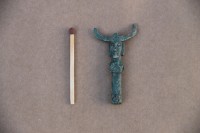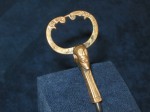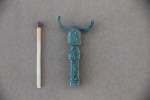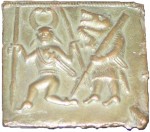 Søren Andersen was scanning a field near Mesinge on the Danish island of Funen this summer when he discovered a figurine of bearded man with a tidily combed pageboy haircut wearing a helmet adorned with what looked like two oversized curved horns. Less than two inches high, the figurine was originally part of a ringed pin, a long pin with a ring at the head used to fasten clothes. Its style dates it to the 8th century.
Søren Andersen was scanning a field near Mesinge on the Danish island of Funen this summer when he discovered a figurine of bearded man with a tidily combed pageboy haircut wearing a helmet adorned with what looked like two oversized curved horns. Less than two inches high, the figurine was originally part of a ringed pin, a long pin with a ring at the head used to fasten clothes. Its style dates it to the 8th century.
 The “horns” on the helmet are probably not actual horns. Viking helmets were not horned, despite their frequent appearances in literature, comics, film and Wagnerian extravaganzas. (In fact, it was a production of Wagner’s Der Ring des Nibelungen at the first Bayreuth Festival in 1876 that launched the image of the Viking in a horned helmet. Read Roberta Frank’s fantastic paper on the subject here.) A number of similar figurines have been found in Scandinavia and Russia, and archaeologists have interpreted the horns as stylized representations of Odin’s ravens Huginn and Muninn.
The “horns” on the helmet are probably not actual horns. Viking helmets were not horned, despite their frequent appearances in literature, comics, film and Wagnerian extravaganzas. (In fact, it was a production of Wagner’s Der Ring des Nibelungen at the first Bayreuth Festival in 1876 that launched the image of the Viking in a horned helmet. Read Roberta Frank’s fantastic paper on the subject here.) A number of similar figurines have been found in Scandinavia and Russia, and archaeologists have interpreted the horns as stylized representations of Odin’s ravens Huginn and Muninn.
 I know what you’re thinking. Those don’t look anything like ravens, and you’re right. They don’t. But they’re also not complete. You can see the “horns” are different sizes and have rough edges. If you look at these two comparable figurines in the National Museum of Denmark, when intact, what look like horns now could have been a circular headdress terminating in two bird heads. The idea is to represent his information-gathering ravens as flying above the Odin’s head.
I know what you’re thinking. Those don’t look anything like ravens, and you’re right. They don’t. But they’re also not complete. You can see the “horns” are different sizes and have rough edges. If you look at these two comparable figurines in the National Museum of Denmark, when intact, what look like horns now could have been a circular headdress terminating in two bird heads. The idea is to represent his information-gathering ravens as flying above the Odin’s head.
 It’s also possible that the figurine doesn’t represent Odin himself, but a follower wearing an outfit associated with the deity. A cast-bronze die from the Vendel Period (550-790 A.D.) found on the Swedish island of Öland depicts a man in a bear suit next to a dancing warrior carrying a spear and wearing a helmet with circular “horns” that end in bird heads. The man dressed like a bear has been interpreted as a berserker devotee of Odin who had many shape-shifting adventures, the dancing warrior as Odin. The helmeted warrior was also thought to be a berserker at one time, his outfit an homage to Odin, but recent scans of the die found that the warrior has only one eye, an iconic attribute of the deity. The Mesinge figure appears to have two eyes.
It’s also possible that the figurine doesn’t represent Odin himself, but a follower wearing an outfit associated with the deity. A cast-bronze die from the Vendel Period (550-790 A.D.) found on the Swedish island of Öland depicts a man in a bear suit next to a dancing warrior carrying a spear and wearing a helmet with circular “horns” that end in bird heads. The man dressed like a bear has been interpreted as a berserker devotee of Odin who had many shape-shifting adventures, the dancing warrior as Odin. The helmeted warrior was also thought to be a berserker at one time, his outfit an homage to Odin, but recent scans of the die found that the warrior has only one eye, an iconic attribute of the deity. The Mesinge figure appears to have two eyes.
 It is currently on display at the Viking Museum at Ladby with other exceptional metal detector finds, like the gold crucifix that is believed to be the oldest figure of Christ ever discovered in Denmark. After a brief stay, it will move on to the National Museum of Denmark for further study.
It is currently on display at the Viking Museum at Ladby with other exceptional metal detector finds, like the gold crucifix that is believed to be the oldest figure of Christ ever discovered in Denmark. After a brief stay, it will move on to the National Museum of Denmark for further study.